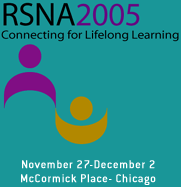
Abstract Archives of the RSNA, 2005
SSJ11-01
Doppler Evaluation of Transjugular Intrahepatic Portosystemic Shunts (TIPS) Functionality: Analysis of a 12 Year Prospective Database
Scientific Papers
Presented on November 29, 2005
Presented as part of SSJ11: Ultrasound (Liver)
Abraham Rafie MD, Abstract Co-Author: Nothing to Disclose
Ross Woolley PhD, Abstract Co-Author: Nothing to Disclose
Juyoung Adam Jung MD, Presenter: Nothing to Disclose
Gerald Dewey Dodd MD, Abstract Co-Author: Nothing to Disclose
To investigate the clinical value of Doppler ultrasound (US) in view of the marked variation in its published efficacy in predicting TIPS dysfunction.
A prospective 10 year TIPS database included 1,188 US on 317 patients with 228 having venograms enabling a comparative analysis. US exam was standardized with the portal vein, stent (proximal, middle and distal) and hepatic vein flow evaluated. US results were dichotomized as abnormal based on one or a combination of the following: an absolute stent velocity <50 or >200cm/s, spatial or temporal stent gradients >50cm/s, or reversal of flow in the proximal draining hepatic vein. Venograms served as the standard for abnormality. Limiting the data set to patients with a venogram led to nonlinearity of the data set which was corrected using the Ln method. Dichotomized data were used to calculate sensitivities and specificities and evaluated by Fisher’s exact Chi Square. ANOVA using sonogram velocities against four primary venogram diagnoses was performed. Dunnett’s post hoc analysis was performed with p≤ 0.05.
Of the 228 venograms, there were 36 normal, 25 occluded, 72 hepatic vein stenoses, and 95 stent stenoses. Sensitivities and specificities of abnormal US stent velocities for detection of any pathology were respectively: 59% and 67% at proximal stent; 58% and 78% at mid stent; and 75% and 64% for temporal mid stent differences. Of 30 patients with reversed hepatic venous flow, 29 had shunt pathology. All Chi Square and ANOVA studies were significant (p<0.01). All post-hoc analyses showed one or more significant difference.
Absolute and temporal US velocity criteria demonstrate statistically significant patterns and sufficiently high sensitivities and specificities to be of clinical value in predicting TIPS dysfunction. Limited sensitivity emphasizes the need for utilization of additional clinical information in the assessment of TIPS functionality. The overall specificity of TIPS US is likely greater than reported due to selection bias present in most studies.
Rafie, A,
Woolley, R,
Jung, J,
Dodd, G,
Doppler Evaluation of Transjugular Intrahepatic Portosystemic Shunts (TIPS) Functionality: Analysis of a 12 Year Prospective Database. Radiological Society of North America 2005 Scientific Assembly and Annual Meeting, November 27 - December 2, 2005 ,Chicago IL.
http://archive.rsna.org/2005/4414121.html

